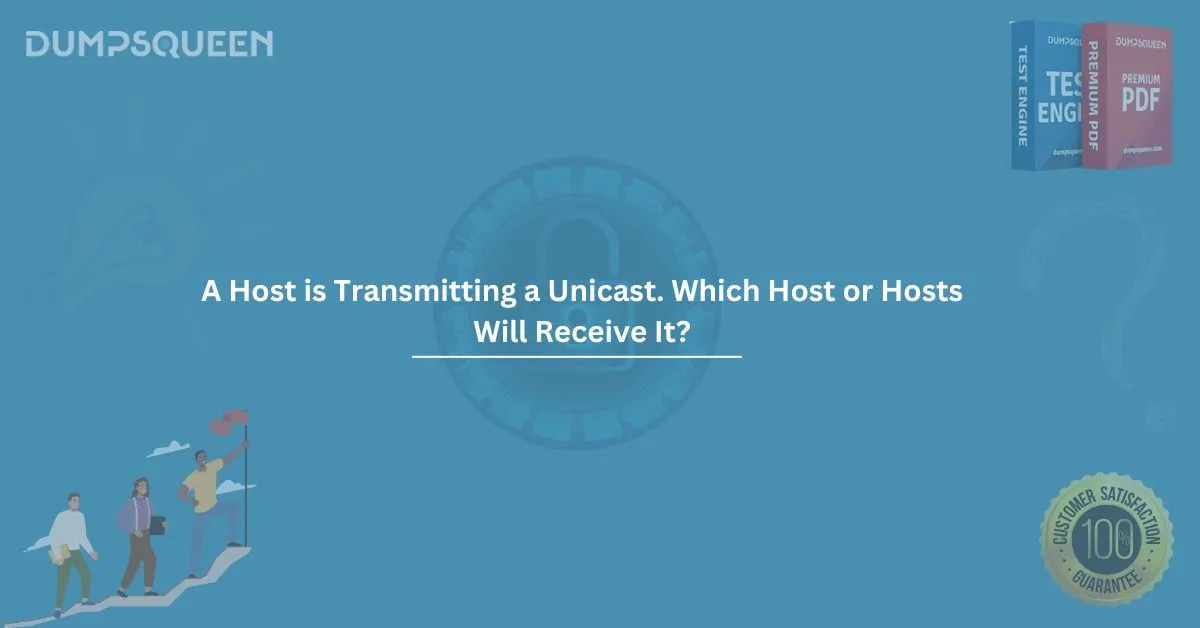In modern networking, communication between devices is integral to the efficient functioning of any system, especially in environments that rely heavily on data transfer. One such type of communication is unicast transmission, which is commonly used in both local area networks (LANs) and wide area networks (WANs). In this blog, we will break down what unicast is, how it works, and which host or hosts will receive it when transmitted by a sender. We'll also dive into some multiple-choice sample questions to further enhance understanding.
What is Unicast Transmission?
Unicast transmission refers to the process where data is sent from one host to a single destination host. Unlike broadcast or multicast, where data is sent to multiple hosts, unicast is specifically one-to-one communication. The sender identifies the intended receiver by using the receiver's unique network address, such as an IP address.
This is the most common form of communication over the internet, as most communications, such as web browsing, email, and other internet services, rely on unicast transmission. When a host transmits data via unicast, it is directed toward a specific destination, ensuring that only the intended recipient receives the data.
How Does Unicast Work?
To understand how unicast works, it's essential to know the basic network layer operations that make it possible.
- Sender’s Addressing: The sender’s device determines the target IP address, which belongs to the host that should receive the data. The sender encapsulates the data in packets, using this destination address.
- Routing the Data: The packet, encapsulated with the destination IP, travels through the network toward the destination host. Routers and switches along the way help direct the packet through various paths based on network topologies and routing protocols.
- Receiver Acknowledgement: Upon receiving the data, the destination host sends an acknowledgment back to the sender, indicating that the message has been successfully received.
This entire process ensures that the data reaches only the target host and no others.
Which Host or Hosts Will Receive a Unicast Transmission?
The key question that arises is: Which host or hosts will receive a unicast transmission?
- The Specific Target Host: Since unicast communication is one-to-one, only the host with the corresponding destination address will receive the data. The receiver is identified by its unique IP address. For instance, if Host A sends a packet to Host B’s IP address, Host B will be the only one to receive that transmission. No other host, even if it shares the same network, will receive the data.
- In the Case of a Router: If the data must travel through one or more routers, the data will still be directed to the specific destination host. Each router makes decisions based on routing tables, ensuring that the packet continues to its final destination without being delivered to any unintended host.
- Network Boundaries: Unicast packets cannot cross network boundaries unless explicitly routed. Therefore, within a subnet or network, only the device with the correct IP address will accept and process the unicast transmission. If multiple subnets are involved, routers will ensure that the packet only reaches the correct network segment.
In conclusion, the host that receives a unicast transmission is determined solely by the destination IP address provided by the sender. If any host other than the intended target receives the transmission, it’s likely due to a misconfiguration or error in network settings.
Why is Unicast Important?
Unicast plays a pivotal role in network communication for several reasons:
- Efficiency: Unicast ensures that only the necessary host receives the data, reducing unnecessary load on other devices and improving overall network efficiency.
- Simplicity: The one-to-one nature of unicast makes it straightforward to implement and troubleshoot.
- Control: Because data is directed at a specific device, unicast provides greater control over data delivery and security.
Final Words
In conclusion, unicast transmission is a fundamental form of data communication used in networks where one host sends data to another specific host. Understanding which hosts receive unicast transmissions is critical to understanding network protocols and optimizing network performance. By focusing on the destination IP address, unicast ensures that only the intended recipient receives the data, making it a highly efficient communication method in modern networking environments.
Sample MCQ Questions on Unicast Transmission
Here are some sample multiple-choice questions (MCQs) to test your understanding of unicast transmission.
Question 1: Which of the following is true about unicast transmission?
A) The data is sent to multiple hosts.
B) The data is sent to a specific host only.
C) The data is sent to a group of hosts in the same network.
D) None of the above.
Answer: B) The data is sent to a specific host only.
Question 2: What is required for a host to receive a unicast transmission?
A) The host must be part of a multicast group.
B) The host must have the same IP address as the sender.
C) The host must have the matching destination IP address.
D) The host must be on the same subnet as the sender.
Answer: C) The host must have the matching destination IP address.
Question 3: Which of the following is NOT a characteristic of unicast transmission?
A) One-to-one communication.
B) Sent to a specific destination host.
C) Can be sent to multiple hosts at once.
D) More efficient in network utilization compared to broadcast.
Answer: C) Can be sent to multiple hosts at once.
Question 4: In unicast communication, what ensures that only the destination host receives the data?
A) Routing tables and destination IP address.
B) Network hubs.
C) Broadcast messages.
D) Data encryption.
Answer: A) Routing tables and destination IP address.




